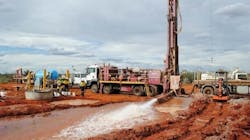Arafura Tapping APA to Develop Gas-Fired Cogeneration to Power Rare Earth Mining in Australia
Australian-based minerals exploration firm Arafura, which has vowed to reach net-zero greenhouse gas emissions by 2050, is also proposing to contract for a gas-fired cogeneration plant, essentially a giant microgrid, to supply energy directly to a project mining rare earth elements needed for advanced green technologies.
Arafura is contracting fellow Aussie company APA to begin early engineering, design and project development for the cogeneration plant to supply electricity and heat for the Nolans Rare Earth Project. Arafura’s Nolans Project includes a rare earth mine, processing plant and infrastructure some 135 kilometers north of Alice Springs in the nation's northern region.
If completed and commissioned, APA would be independent power provider connecting the plant’s electricity generation directly to the mining and processing operation under a long-term power purchase agreement. The cogeneration plant likely could be connected to an APA natural gas pipeline, as well.
The deal still needs numerous company and regulatory approvals. The Arafura Nolans project would mine for neodymium and praseodymium—minerals used in production of components for electric vehicles, wind turbines and electronics, according to the report. It also provides an alternative to China-sourced rare earth elements.
Arafura Rare Earths has secured more than $1 billion in funding for the project. It hopes to reach completion on the mine by 2025.
“We are excited to play this role in the global decarbonization process and contribute towards bringing these critical minerals to market,” APA CEO Adam Watson said in a statement. “We will also work with Arafura to explore how can deliver a bundled energy solution, pairing reliable gas firming with renewables for the project.”
More on Microgrids in Australia: AGL to supply Solar-Storage for Almond operations
Microgrids in Mining Operations
The Nolans site is estimated to hold about 56 million metric tons of rare earth ore reserves, according to Arafura. Especially important are the deposits of NdPr oxide, or the non-separated oxide of neodymium and praseodymium.
Among its announced goals toward net zero GHG emissions by 2050, Arafura has indicated a commitment toward concentrated solar thermal energy for steam generation in the decades ahead.
The company, however, also has acknowledged the current market and need for natural gas and the commercial viability considerations of its energy decisions.
“We recognize we will need to address a range of challenges in decarbonizing rare earth processing, which is, by its nature, an energy intensive process,” Arafura Rare Earth’s Managing Director Gavin Lockyer was quoted as saying in the company’s most recent sustainability report.
“Nonetheless, the Arafura team is committed to implementing a practical, cost-efficient pathway to net zero. We will keep a close watch on changes in the price, technology maturity and availability of relevant technologies, such as long-duration energy storage, and update the GHG emissions reduction pathway in future if it is appropriate to do so.”
Traditional power generation equipment manufacturers such as Caterpillar and MTU, among others, are working on cleaner microgrid solutions for often carbon-intensive mining operations around the world. The mining firms are looking for renewable and cleaner energy alternatives to coal and diesel, which carries troublesome environmental and supply challenges.
Natural gas, meanwhile, can reduce carbon dioxide emissions by 50 to 60 percent compared to coal-fired power and lower CO2 and nitrous oxide than diesel, according to reports. However, natural gas is made up mainly of methane, itself considered a worse greenhouse gas than CO2 by many environmental scientists.








